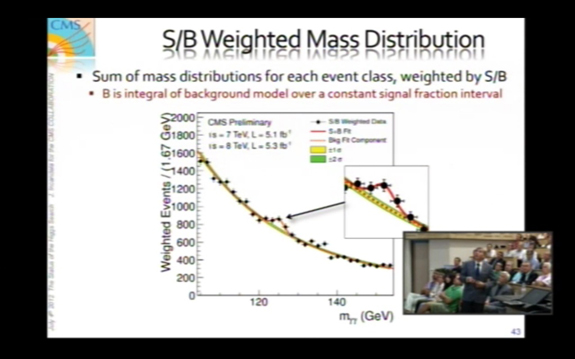Physicists Pin Down New Particle, Won’t Quite Call It the Higgs

The small bump on an otherwise smooth curve shows one part of the proof for the discovery of the new particle. Photo: CERN/CMS h/t Sarah Kavassalis
Today, scientists announced that they have found a new type of particle. It is a claim that, up until just a few short weeks ago, no one was confident in making. The finding rests on the shoulders of two separate experiments—ATLAS and CMS—both being run at the Large Hadron Collider. CERN, the organization that runs the LHC, says,
The ATLAS and CMS experiments presented their latest preliminary results in the search for the long sought Higgs particle. Both experiments observe a new particle in the mass region around 125-126 GeV.
The GeV measure stands for gigaelectron volts, a unit of energy. Or, through Einstein’s famous E=mc2, a unit of mass—implying that the newly found particle is very heavy and very similar to the long-sought Higgs boson.
CERN says,
“The results are preliminary but the 5 sigma signal at around 125 GeV we’re seeing is dramatic. This is indeed a new particle. We know it must be a boson and it’s the heaviest boson ever found,” said CMS experiment spokesperson Joe Incandela. “The implications are very significant and it is precisely for this reason that we must be extremely diligent in all of our studies and cross-checks.”
Now that the scientists are confident that there is, in fact, a particle in their sights, the work will turn to trying to tease out the specifics and to seeing if their new particle matches up with the behavior of the still-theoretical Higgs boson. According to the Guardian,
The discovery of the Higgs particle ranks as one of the most important scientific advances of the past 100 years. It proves there is an invisible energy field that pervades the vacuum of the known universe. This field is thought to give mass to the smallest building blocks of matter, the quarks and electrons that make up atoms. Without the field, or something like it, there would be no planets, stars, or life as we know it.
In clever comic form, PHD Comics explains:
<iframe frameborder="0" height="575" src="http://player.vimeo.com/video/41038445?portrait=0&color=c8b3df" width="438"></iframe>
For more detail, Discover bloggers put together a full live blog of the scientific presentation that announced the discovery. And Scientific American lined up Columbia University physicist Michael Tuts, who works on the ATLAS experiment, to break down the early-morning presentation, in a chat which starts today at 11 am EDT.
More from Smithsonian.com:
/https://tf-cmsv2-smithsonianmag-media.s3.amazonaws.com/accounts/headshot/smartnews-colin-schultz-240.jpg)
/https://tf-cmsv2-smithsonianmag-media.s3.amazonaws.com/accounts/headshot/smartnews-colin-schultz-240.jpg)